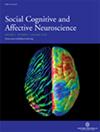体感系统在情绪感受中的作用:一项神经刺激研究
IF 3.1
2区 医学
Q2 NEUROSCIENCES
引用次数: 0
摘要
情绪体验深深地影响着我们的身体状态,例如当我们感到 "愤怒 "时,我们的拳头会紧握,脸会发烫。最近的研究表明,情绪可以映射到特定的身体区域,这表明初级躯体感觉系统(S1)可能在情绪处理中发挥作用。然而,迄今为止,S1 在情绪产生中的因果作用仍不清楚。为了解决这个问题,我们对 S1 施加了不同频率(β、θ 和假)的经颅交变电流刺激(tACS),同时参与者看到了不同愉悦程度和唤醒水平的情绪刺激。结果表明,对 S1 的调制会影响主观情绪评级,这与所应用的频率有关。虽然θ和β-tACS使参与者对情绪图像的评价更愉快(更高的价值),但只有θ-tACS降低了主观唤醒评价(更平静)。在整个实验过程中记录的皮肤传导反应证实,愉快与不愉快的刺激会引起不同的唤醒。我们的研究揭示了 S1 在情绪感受中的因果作用,为情绪的体现本质增添了新的见解。重要的是,我们提供的因果证据表明,贝塔频率和θ频率对情绪的两个维度--唤醒和情绪价值--的调节作用不同,这证实了情绪的这两个维度之间存在分离的观点。本文章由计算机程序翻译,如有差异,请以英文原文为准。
The role of the Somatosensory system in the feeling of emotions: a neurostimulation study
Emotional experiences deeply impact our bodily states, such as when we feel ‘anger’, our fists close and our face burns. Recent studies have shown that emotions can be mapped onto specific body areas, suggesting a possible role of the primary somatosensory system (S1) in emotion processing. To date, however, the causal role of S1 in emotion generation remains unclear. To address this question, we applied transcranial alternating current stimulation (tACS) on the S1 at different frequencies (beta, theta and sham) while participants saw emotional stimuli with different degrees of pleasantness and level of arousal. Results showed that modulation of S1 influenced subjective emotional ratings as a function of the frequency applied. While theta and beta-tACS made participants rate the emotional images as more pleasant (higher valence), only theta-tACS lowered the subjective arousal ratings (more calming). Skin conductance responses recorded throughout the experiment confirmed a different arousal for pleasant vs unpleasant stimuli. Our study revealed that S1 has a causal role in the feeling of emotions, adding new insight into the embodied nature of emotions. Importantly, we provided causal evidence that beta and theta frequencies contribute differently to the modulation of two dimensions of emotions - arousal and valence - corroborating the view of a dissociation between these two dimensions of emotions.
求助全文
通过发布文献求助,成功后即可免费获取论文全文。
去求助
来源期刊
CiteScore
6.80
自引率
4.80%
发文量
62
审稿时长
4-8 weeks
期刊介绍:
SCAN will consider research that uses neuroimaging (fMRI, MRI, PET, EEG, MEG), neuropsychological patient studies, animal lesion studies, single-cell recording, pharmacological perturbation, and transcranial magnetic stimulation. SCAN will also consider submissions that examine the mediational role of neural processes in linking social phenomena to physiological, neuroendocrine, immunological, developmental, and genetic processes. Additionally, SCAN will publish papers that address issues of mental and physical health as they relate to social and affective processes (e.g., autism, anxiety disorders, depression, stress, effects of child rearing) as long as cognitive neuroscience methods are used.

 求助内容:
求助内容: 应助结果提醒方式:
应助结果提醒方式:


